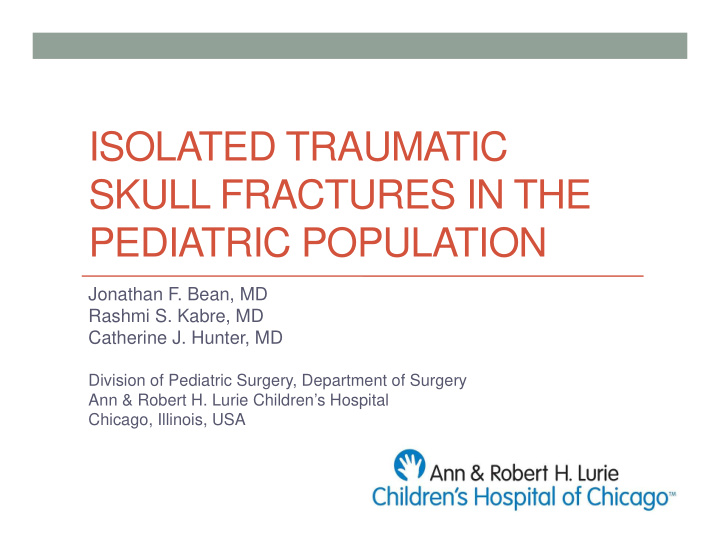



ISOLATED TRAUMATIC SKULL FRACTURES IN THE PEDIATRIC POPULATION Jonathan F. Bean, MD Rashmi S. Kabre, MD Catherine J. Hunter, MD Division of Pediatric Surgery, Department of Surgery Ann & Robert H. Lurie Children’s Hospital Chicago, Illinois, USA
Disclosures • No financial disclosures
Introduction • Blunt head injury accounts for the majority of pediatric trauma in the United States • Although a majority of patients with skull fractures will have associated intracranial pathology, a fraction of these patients have a normal physical examination and an isolated skull fracture on head CT
Skull Fracture
Skull Fracture
Hypothesis • There is a paucity of evidence to guide the management of blunt trauma patients with an isolated skull fracture without intracranial hemorrhage • We hypothesized that neurologic decline is rare in patients with an isolated skull fracture from blunt head trauma and repeat imaging usually is unnecessary
Materials and Methods • Single center retrospective review • Inclusion criteria • Blunt trauma • Isolated skull fracture on head CT • Normal neurological examinations • Exclusion criteria • Intracranial hemorrhage • Penetrating trauma • Depressed skull fractures or skull base involvement • Pneumocephalus • Poly-trauma or concern for non-accidental trauma • June 2004 to June 2014
Results • 71 patients • 16 patients (22.5%) were discharged from the emergency department • 55 patients (77.5%) were admitted for inpatient observation and serial neurologic examinations
Results Female Male 44% 56%
Results: Age Distribution 30 25 20 15 10 5 0 < 6 months 6 months - 1 1 - 3 years 3 - 5 years 5 - 7 years 7 - 9 years 9 - 11 years 11 - 13 years > 13 years year
Results • 0 patients needed neurosurgical intervention in either group • 4.2% of patients underwent repeat imaging • No association between age and repeat imaging (p = 0.7474) • No association between age and inpatient observation (p = 0.4074)
Conclusions • An isolated traumatic skull fracture in a patient with normal neurologic examination has a very low likelihood of needing neurosurgical intervention • An isolated skull fracture is not necessarily an indication for admission and neurologic observation • Further studies are needed to determine the indications for inpatient observation in pediatric blunt head trauma patients
Thank You!
Recommend
More recommend